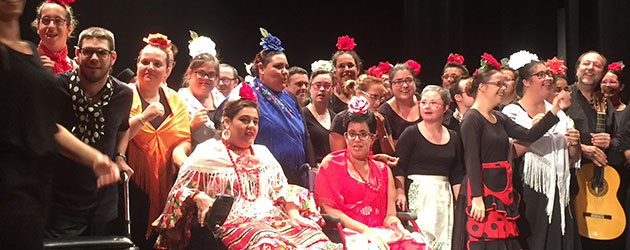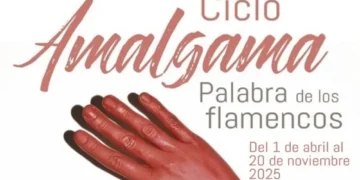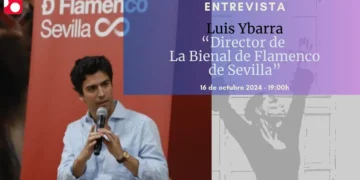Text & photos: Silvia Cruz Lapeña
Organizations of disabled people celebrate a gala show at the Hogar Virgen de los Reyes to show what was learned at the workshops organized by the Aula Arte for the Bienal.
Flamenco dancers don’t look at the floor
At the door of the Hogar Virgen de los Reyes, visitors arrive all dressed up. “Come here, let me put your lipstick on for you”, says one woman to a girl dressed in a ruffled dress with a flower in her hair. The families and friends of the 60 people who took the course “Integration through Flamenco” within the program of the Bienal, are waiting for their people to appear on stage to show what they learned in the classes. They have doubts, how could they not?, considering the handicaps these artists must deal with.
Backstage, the students talk non-stop, and their chattering combines with the sound of wheel-chairs that go in and out of the patio of the theater, and of the monitors who give orders to try make everything come out right. You can see they’re nervous. Cristina Aguilar, conservatory teacher and dancer trained in Spanish dance was the person in charge of teaching them everything they know. «I have a cousin with Down’s syndrome, and that got me interested in the handicapped”. She explains that her idea is to found a specialized school, but in the meantime, to work with Arte Aula, the group that organized the course included in the Bienal program.
Everywhere
Among the audience, friends and relatives anxious to see their people. The seven groups arrive on stage to show their work. The autistic girls dance sevillanas accompanied by monitors, and only move their arms. The crowd is with them all the way with encouraging cheers, and by the third piece, one has gotten lost and another came upstairs. There’s always something sad in measured movements, but in this case, there was also a lesson. The classes are grouped under the activities of “Flamenco is Everywhere”, and seeing these people perform, it’s clear that is the case.
It’s due to a flaw in the brain that the hands cannot be moved voluntarily, or a joint that was born dead only moves by will-power. In those spaces and faults, music also goes in, because that is the only thing able to go anywhere. Even those who cannot hear it, sense its sound. Even that boy who went out to dance tangos with the help of a walker, and he moves and smiles feeling it’s possible to break into a run.
A different handicap
In the seven performances, two professionals accompany the artists: singer Laura Román, and guitarist Antonio Gámez. The voice and guitar are absolutely necessary for the dancer, it’s an act of patience and generosity on behalf of those who do the accompaniment, and in this case, it’s multiplied. Román and Gámez have it quite clear today that they are not going to stand out or be applauded. And they don’t mind adjusting the music, speeding up or holding back, to adapt to this group of amateur artists.
Nor does Cristina Aguilar mind reminding them as often as necessary to smile and not look at the floor. She’s among the audience, at the front of the stage, serving as a mirror for her students. “It just grabs your heart, doesn’t it?” says one lady who has come to see her neighbor dance. And yes, it does grab your heart. Just seeing how they give everything, until there’s nothing left, to move the show forward. And it’s heartbreaking to see that backstage there isn’t even a little ramp to help them up to the dressing-rooms on the next floor, and which reminds you of the many obstacles still present in public places.
For that reason, and others, the presence of this show in a national and international event such as the Bienal de Flamenco de Sevilla, is a fine showcase to remember all the organizations that havve been working since the end of the nineteen-seventies to give dignity to these families. They do so without anger, only remembering their history of constant struggle, and they do it only a few meters from the Andalusian Parliament where some members of the PSOE party are leaving for Madrid ready to battle it out with their own, while here, a gentleman with Down’s syndrome leaves everyone enthralled with a movement of his hips. But the politicians have other business today, and their handicap is of a different type.
From pity to joy
The show continues, and the audience’s first tears have changed into joy. “This is a real show” now says the lady whose heart was broken earlier, and she continues to cheer her neighbor on, a young man with cerebral palsy in a wheelchair, and whose job it is to interpret a fandango. Once the pity is done with, the humor begins, and the friends and parents start to realize they don’t do it well, but who cares…
“Most of them are lacking in coordination, and have mobility problems, but dancing is very good for them, it gives them flexibility, it activates them and they improve rapidly” explains Aguilar to DeFlamenco several days before the show. “As soon as I put on the shoes, I look just right” Mónica Reyes de la Rosa explained in the rehearsal. She’s from Valencia, raised in Seville, 43 years old and a member of the Asociación de Familiares, Allegados y Personas con Trastorno Mental Grave (ASAENES). During the rehearsal of the tanguillos, she showed great rhythm, and the fact is, she was better in the practice session than the performance. “The shoes, as soon as I get them on, everything changes”.
“Move your behind, come on, come on, let’s go. And smile, if you don’t mind, smile and look out at the audience”. All Aguilar’s orders during the rehearsals are followed on-stage only halfway, but she is satisfied all the same. And so is the audience, and that’s why the event turned into one big party.
Among the artists there’s also a lot of kidding around, they laugh about how badly a certain step came out, and joke about their lack of rhythm. “Don’t you think I’m laughing too much?” says one fifty-something man to Cristina during the rehearsal while he struggles to remember not to look at the floor. “It doesn’t matter, the important thing is not to look at the floor, not on-stage or anywhere else” answers the teacher almost without thinking. That was the advice that was best followed on stage. And the most valuable.
Descubre más desde Revista DeFlamenco.com
Suscríbete y recibe las últimas entradas en tu correo electrónico.






























